Affiliate links on Android Authority may earn us a commission. Learn more.
Best of Android 2015: Performance
December 10, 2015
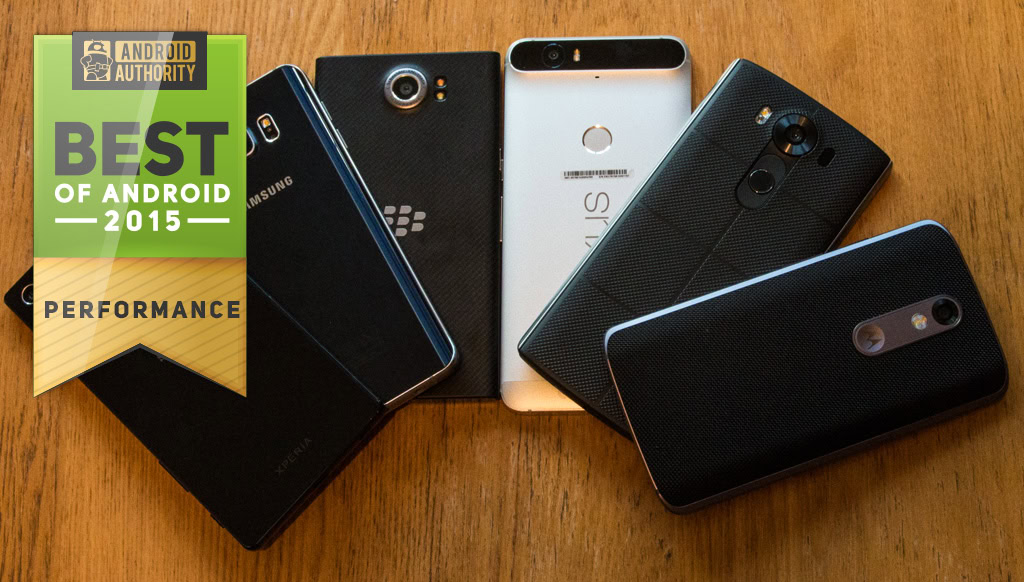
What is Best of Android?
In Best of Android, we take the hottest devices of the moment and compare them in-depth. For this first edition, we picked up the following Android flagships:
- Sony Xperia Z5 Premium
- Nexus 6P
- Motorola Moto X Force
- Samsung Galaxy Note 5
- LG V10
- BlackBerry Priv
What about the Galaxy S6 or the HTCOne M9 or the OnePlus 2, you ask. Those are all great phones. But, to keep this comparison manageable, we selected only the phones we feel are the most representative for the ecosystem right now.
Read more about Best of Android. Thanks for being a part of Android Authority!
Everyone always asks what’s the best phone to buy and we’re taking the guesswork out of that question. For this installment in Best of Android 2015, we’re taking a look at performance: which Android smartphone has the best performance? Let’s take a look.
As a reminder, the devices we are testing (in no particular order) are the Sony Xperia Z5 Premium, the LG V10, the Nexus 6P, the Moto X Force, the BlackBerry Priv, and the Samsung Galaxy Note 5.
AnTuTu
AnTuTu is one of the “standard” benchmarks for Android, it measures both CPU and GPU usage as well as a few other things like RAM bandwidth and I/O throughput. Although all of its workloads are completely artificial, meaning they don’t reflect real world usages, the benchmark is useful for establishing a baseline about the general performance of a device.
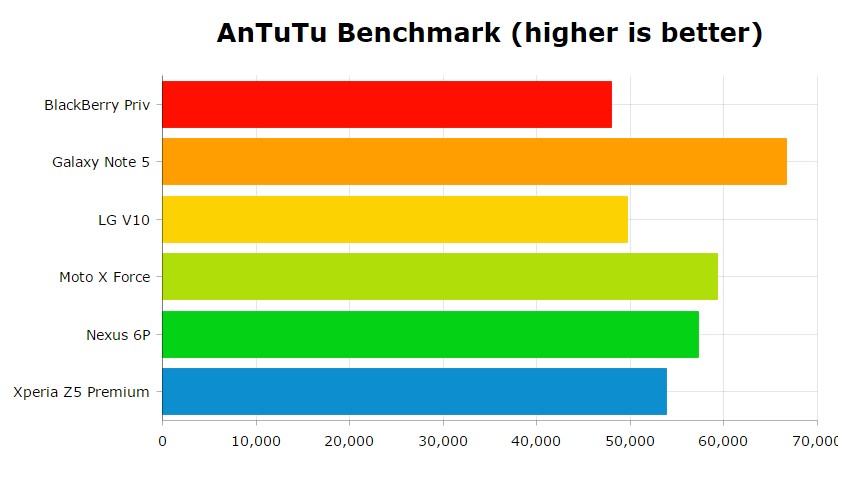
As you can see the Galaxy Note 5 comes out on top due to the great performance of the Exynos 7420 SoC. However, close behind is the Moto X Force which uses the Snapdragon 810 from Qualcomm. In fact second, third and fourth place are all taken by phones using the Snapdragon 810. Fifth is the LG V10 which uses the hexa-core Snapdragon 808 and in last place comes the Blackberry Priv, which also uses the hexa-core Snapdragon 808. It is interesting to note that five of our six devices all use Qualcomm Snapdragon processors, either the octa-core 810 or the hexa-core 808. However the Exynos 7420 proves yet again that it is the top SoC of 2015.
GeekBench
GeekBench is another popular Android benchmarking tool, however this app only tests the CPU performance. The test is split into two parts, the single-core tests, which measures the speed of an individual core, regardless of how many cores there are on the SoC; and the multi-core tests, which exercises all the cores on the SoC simultaneously.
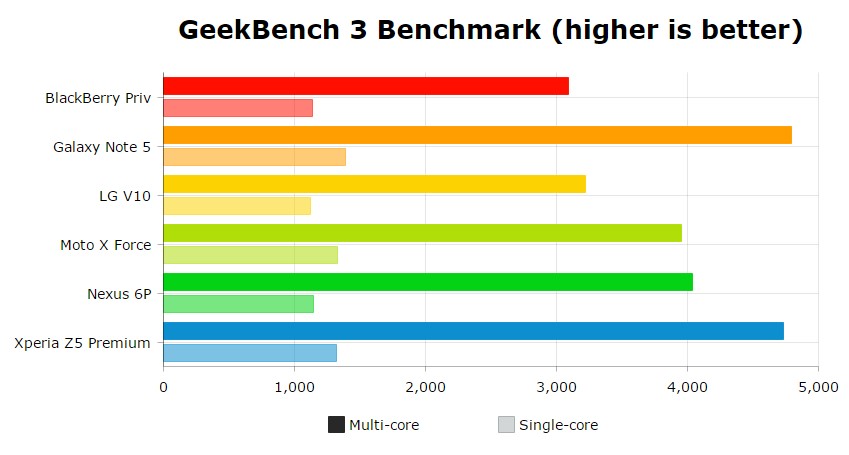
As with the AnTuTu tests the Note 5 comes out top, however this time we see a strong performance from the Sony Z5 Premium. Its single-core result is only slightly less than the Note 5, as is its multi-core score. What is interesting is that the Moto X Force and the Nexus 6P didn’t match the pace of the Z5 Premium for this test. All things being equal they should have performed better as they are using the same System-on-a-Chip, clocked at the same frequency.
The two hexa-core phones come in fifth and sixth, mainly “hampered” by having only 6 cores rather than 8, something penalized by the multi-core tests.
Basemark OS II
Basemark OS II is an “All-In-One” benchmark that tests the overall performance of a device including system, memory, graphics, and web browsing. As well as these individual scores there is a overall rating calculated.
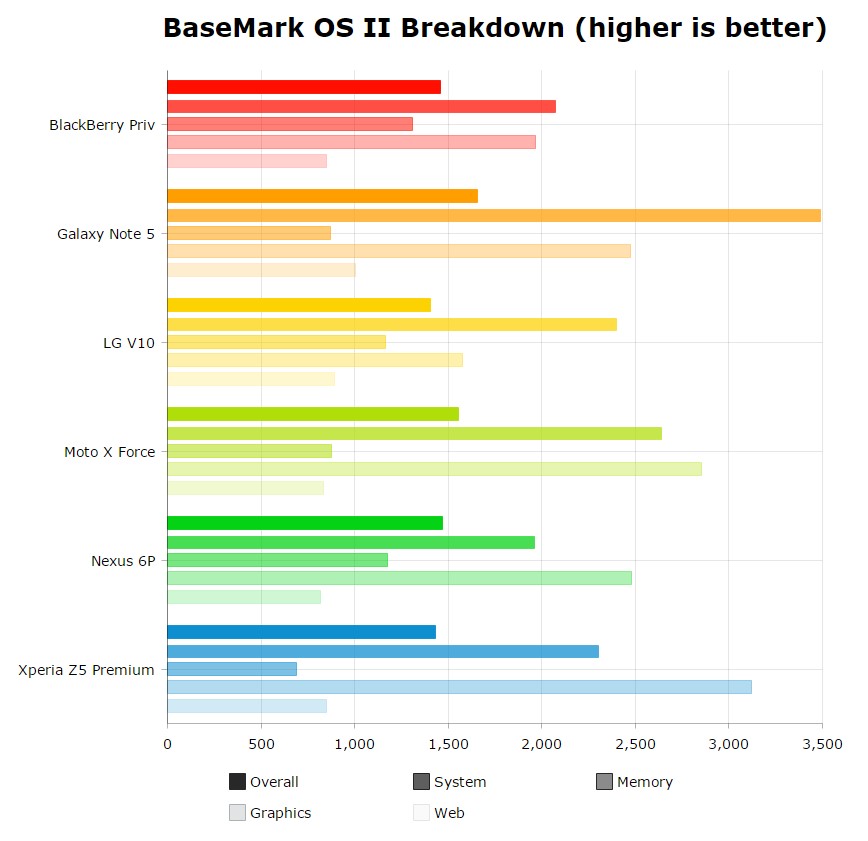
Until now a clear pattern was forming: The Note 5 first, followed by the three Snapdragon 810 devices and then the two Snapdragon 808 handsets. However the Basemark OS II test has shaken things up, just a little. The Note 5 is still top and second place goes to the Moto X Force. In third is the Nexus 6P, but in forth comes the BlackBerry Priv, a Snapdragon 808 device, and not the Z5 Premium as you would have expected. The Priv did well on the memory subsystem tests, in fact it got the highest score for that test, even beating the Note 5. At the same time the Z5 Premium did badly on the memory tests. The result is that the overall score for the Priv is higher. This unfortunately leaves the LG V10 in last place.
3D Mark Slingshot
3DMark is probably the world’s leading benchmark tool because of its cross-platform nature and because of its emphasis on 3D graphics. The Slingshot tests are designed specifically for devices running Android 5.0 or later that support OpenGL ES 3.1 or ES 3.0. For this test run we picked OpenGL ES 3.1 to test the latest and most advanced features of the GPU.
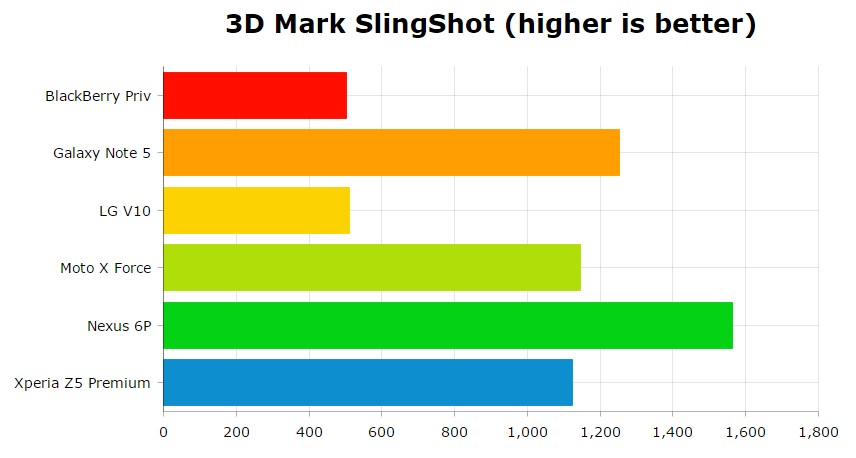
And the results are quite surprising, this is the first test where the Note 5 didn’t win. Instead we have a great performance by the Nexus 6P. Although it has the same SoC as the Motorola and Sony, the Nexus 6P managed an incredible score of 1,565. Next comes the Note 5 with 1,252, closely followed by the other two Snapdragon 810 devices with scores of 1,146 and 1,125 for the Moto X Force and the Z5 Premium respectively. The LG V10 and the Blackberry Priv come in fifth and sixth with the low scores of 510 and 502, a third of the Nexus 6P’s scores.
GFX Highest Frames
Like 3D Mark, GFXBench is primarily concerned with GPU performance. The latest version of the app includes tests for OpenGL ES 3.1 and the Android Extension Pack. This means that it can test devices using game-like content that utilizes Android Extension Pack features such as hardware tessellation.
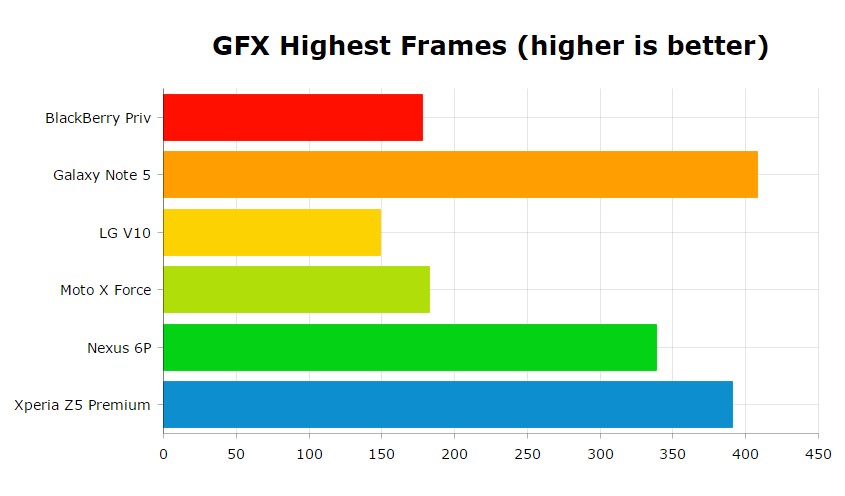
Things return back to the norm with this test, well almost. The Note 5 comes in first, followed by the Z5 Premium and the Nexus 6P. In fourth place is the Moto X Force, but only just. It managed a score of 182.7 Frames, a much lower score than the 390.7 and 338.8 of the Z5 Premium and the Nexus 6P. The Motorola’s score was actually closer to the two Snapdragon 808 devices than to the other Snapdragon 810 handsets.
Lag Test
Benchmarks are one thing, but how long does it take to load your favorite game? This is where the rubber hits the road. The benchmarks mean nothing while you are twiddling your thumbs waiting for a game to load. To test this we started up 6 games in turn on each device and measured how long it took for the game to start. The games we picked were: Brave Frontier, Summoners War, Clash of Clans, Farmville 2, Walking Dead, and Game of Thrones. The results are quite surprising. For example Clash of Clans takes 27 seconds to open on the LG V10, but only 15 seconds on the Note 5.
Here is the average load time for all 6 games:
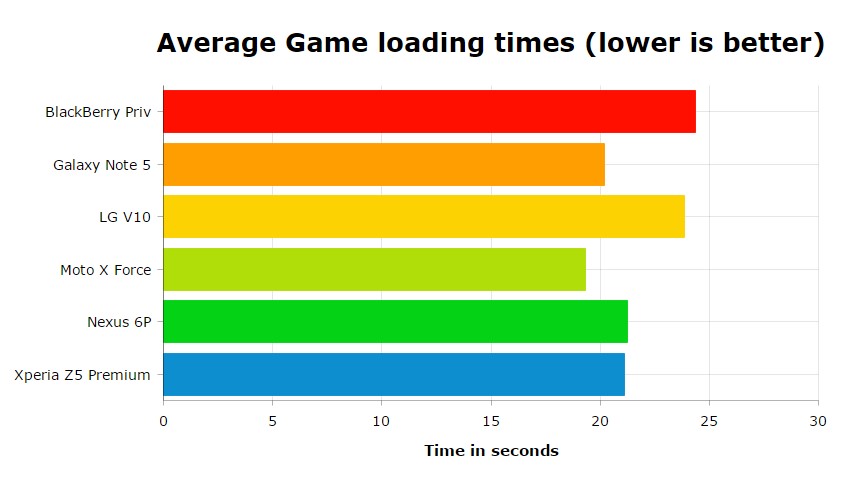
A strong performance from the Moto X Force puts it just ahead of the Note 5. Looking at the individual results it seems that the Note 5 struggled slightly with Farmville 2 which took 24 seconds to open, compared to the 19 seconds for the Moto X Force. Next comes the Sony followed by the Nexus and then the two Snapdragon 808 devices.
Over heating?
One of the things that is often talked about concerning smartphones is overheating. The harder the processor needs to work, the more heat it produces. This is true when playing 3D games and when recording video, especially 4K video. To see how much each phone heats up we conducted two tests, a 1080p video recording test and a 4K recording test. In both cases we noted the temperature rise.
Here are the results for the 1080p tests:
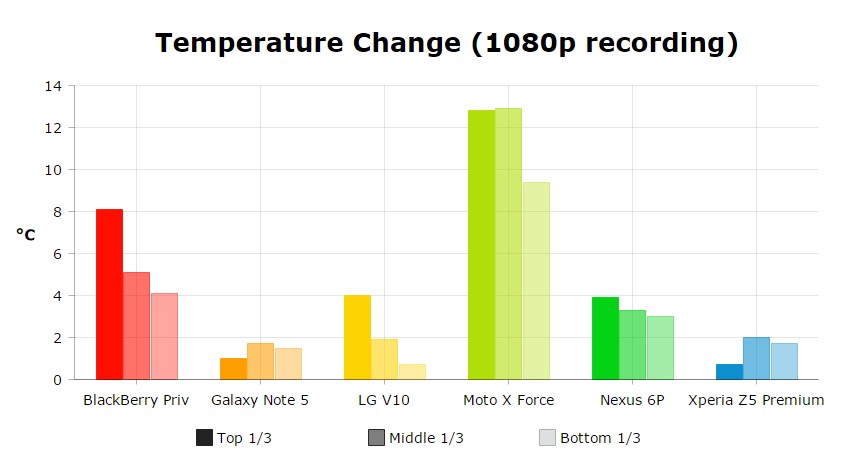
The Moto X experiences the highest temperature rise, over 13C, while the Note 5 only heats up a few degrees. The other phones in our group perform well except the BlackBerry Priv, which heats up by 8C.
So what about 4K:
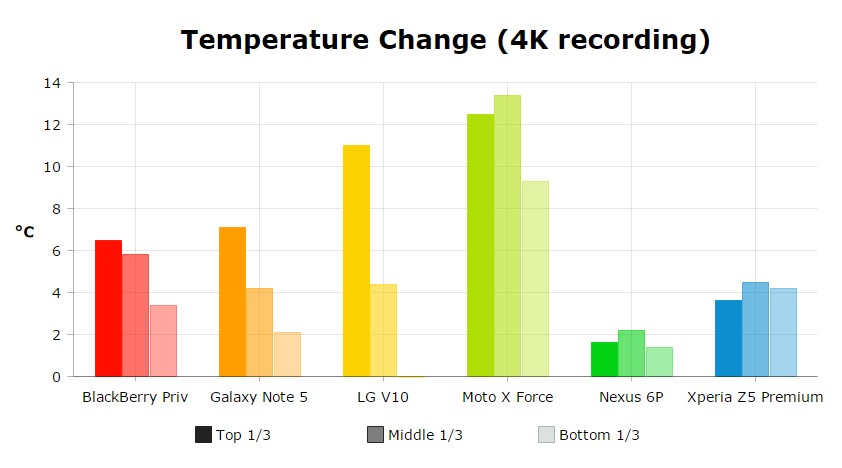
Recording 4K is more arduous for the processor and it causes most of the devices to heat up significantly. Again the Moto X force heats up the most while the other devices also see a significant temperature rise, with the exception of the Nexus 6P and the Z5 Premium.
As one final test we also looked at how much video, both 1080p and 4K each phone could record. There are three possible limits to these recordings. First, a built-in limit set by the manufacturer. Second, running out of internal storage while recording. Third, the phone overheats and the app shuts down. Here is what we found out:
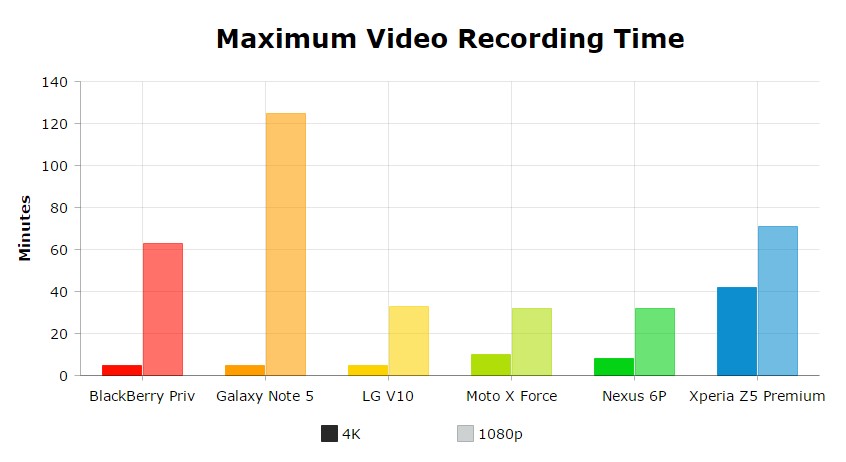
When it comes to 1080p recording the Note 5 is the clear winner with a recording time of over two hours. Next comes the Sony, followed by the BlackBerry. The other three devices manage about 30 minutes each. For 4K recording the story is different. The Note 5, the LG V10 and the BlackBerry Priv all managed just 5 minutes. The Nexus 6P 8 minutes, and the Moto X Force, 10 minutes. However, the winner was the Z5 Premium which managed an impressive 40 minutes.
Wrap up
That is quite a lot of data, so here is my summary. The Note 5 with its octa-core Exynos 7420 processor is clearly the winner. It comes first in nearly every test and on the two occasions when it doesn’t, it came second. Close behind the Note 5 are the Snapdragon 810 based devices. Looking at the scores it is hard to say which one is better than the other two. If I was forced to name one, it would probably be the Moto X Force, but it would be a close call.
At the bottom of the performance table is the LG V10 and the Blackberry Priv. Both use the Snapdragon 808 hexa-core processor and both are fairly evenly matched. However don’t forget that we are comparing the crème de la crème, none of these phones are slow and you won’t be unhappy with the performance of any of them.
Also there is more to a phone than just its raw performance, there are lots of other factors including the display, the audio, the battery, plus unique features like the Priv’s keyboard or the Note 5’s pen.
The bottom line is this, these are all high performance phones and in that sense they are all equal, but as Orwell almost said, it is just that some phones are more equal than others!
Best of Android 2015
All the comparisons:
Credits
Post and video by: Gary Sims
Series Contributors: Rob Triggs, Gary Sims, Lanh Nguyen, Joe Hindy, Krystal Lora
Series Editors: Nirave Gondhia, Bogdan Petrovan, Andrew Grush
Thank you for being part of our community. Read our Comment Policy before posting.